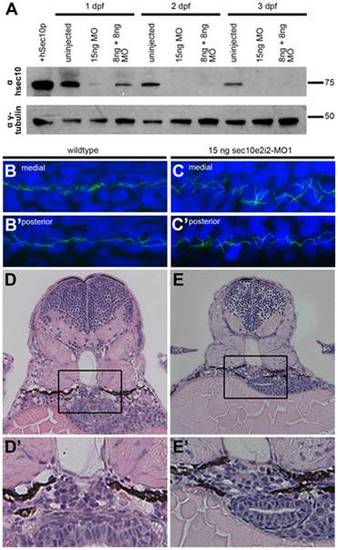- Title
-
The Exocyst Protein Sec10 Interacts with Polycystin-2 and Knockdown Causes PKD-Phenotypes
- Authors
- Fogelgren, B., Lin, S.Y., Zuo, X., Jaffe, K.M., Park, K.M., Reichert, R.J., Bell, P.D., Burdine, R.D., and Lipschutz, J.H.
- Source
- Full text @ PLoS Genet.
|
sec10MO embryos show abnormal pronephric development. (A) Immunoblots showing the 1-3 dpf time course of zfSec10 knockdown in sec10MO embryos. sec10MO injections can lead to abnormal-appearing embryos (Table 1), but in this blot, 3 dpf sec10MO embryo lysates were isolated only from embryos without any obvious morphological defects. This demonstrates that these embryos still have strong knockdown of the zfSec10 protein. Lysates from abnormal-appearing embryos showed similar levels of zfSec10 knockdown (data not shown). 5 embryos loaded per lane. Positive control for Sec10 was from human Sec10 (hSec10) overexpressing MDCK cell lysates. Blot was probed with antibodies against hSec10, and gamma-tubulin as a loading control. (B-C′) Immunofluorescence with antibody against acetylated-tubulin (green), and the nuclear Hoechst stain (blue). Flattened Z-series from confocal imaging of medial (B,C) and posterior kidney (B′,C′), 24 hours post fertilization (hpf), lateral view, 80x magnification. Pronephric cilia length is similar between uninjected embryos (B/B2) and 15ng sec10MO embryos (C/C′); however, cilia within the medial pronephros are disordered (compare B and C). (D-E′) JB-4 resin section (with enlarged inset) of glomerular region, stained with Hematoxylin and Eosin, 3 dpf, transverse 4 μm section, 40x magnification. Wild-type embryos show an organized U-shaped glomerulus (D/D′), while 15ng sec10MO embryos show disorganization (E/E′). PHENOTYPE:
|
|
Knockdown of sec10 partially phenocopies loss of pkd2. (A-F) Gross phenotypes of zebrafish embryos at 3 dpf, lateral view, 4x magnification. Uninjected embryo (A), 4ng pkd2MO embryo with a severe curly tail up (B), 15ng sec10MO embryo with a moderate curly tail up (C). A synergistic interaction resulting in severe curly tail up was observed upon co-injection of sub-optimal doses of 0.25/2ng pkd2 MO +7.5ng sec10MO (D)—which do not result in curly tail up when injected alone (E, F). (G-I′) in situ hybridization for wt1a (with enlarged insets), 3 dpf, dorsal view, 16x magnification. An uninjected embryo with condensed glomerular stain (G/G′), a 4ng pkd2MO embryo with severe enlargement (H/H′), and a 15ng sec10MO embryo with severe enlargement (I/I′). (J) Increased phospho-ERK levels detected by Western blot in 4ng pkd2MO and 8+8ng sec10MO embryos at 5 dpf. One blot, loaded at 2 embryos per lane, was probed with antibody against phospho-ERK, then with antibody against total-ERK. The other blot, with the same lysates as above loaded at 10 embryos per lane, was probed with antibody against hSec10, then with antibody against gamma-tubulin. EXPRESSION / LABELING:
PHENOTYPE:
|

Unillustrated author statements EXPRESSION / LABELING:
PHENOTYPE:
|


